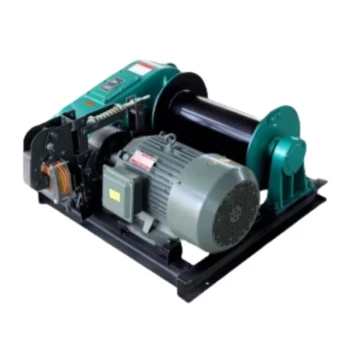A 2000 lb winch is designed to pull up to 2000 lbs in a single-line configuration under ideal conditions, but its actual pulling capacity can vary based on factors like rope layering, angle of pull, and operational constraints. While vertical lifting is prohibited for this winch, its horizontal or inclined pulling power is maximized on the first layer of rope and diminishes with additional layers. Hydraulic and manual winches have different determinants for their capacity, such as operating pressure or gear ratios, but the 2000 lb rating remains a baseline for comparison.
Key Points Explained:
-
Single-Line Pull Capacity
- The 2000 lb rating refers to the winch's ability to pull 2000 lbs in a single-line setup, meaning the rope is wound directly from the drum to the load without any pulley systems.
- This capacity assumes optimal conditions: the first layer of rope on the drum and a straight-line pull (horizontal or slight incline).
-
Prohibition of Vertical Lifting
- Despite the 2000 lb rating, the winch is not designed for vertical lifting due to safety risks and potential mechanical strain.
- Horizontal or angled pulls are the intended use cases, where friction and load distribution are more manageable.
-
Impact of Rope Layering
- The winch's pulling power is highest on the first layer of rope and decreases with each additional layer.
- For example, a winch might pull 2000 lbs on the first layer but only 1800 lbs on the second due to increased drum diameter and reduced mechanical advantage.
-
Comparison to Hydraulic and Manual Winches
- Hydraulic winches rely on operating pressure and gear ratios, which can adjust pulling capacity dynamically.
- Manual winches typically have lower capacities (300 kg–1.2 tons), making the 2000 lb winch a mid-range option for heavier tasks.
-
Practical Considerations
- Angle of Pull: A 45-degree angle increases the effective load on the winch; the actual pull capacity must account for this.
- Rope Integrity: Worn or damaged rope reduces safe working capacity.
- Duty Cycle: Continuous heavy pulling can overheat the motor, requiring intermittent use for longevity.
Ever wondered how a winch's pulling power compares to its lifting capacity? While the numbers might seem similar, the mechanics and safety margins differ significantly. Always consult the manual for specific limitations and prioritize horizontal applications to maximize efficiency and safety. These tools are workhorses for towing and hauling, but their true power lies in understanding their limits.
Summary Table:
| Factor | Impact on Pull Capacity |
|---|---|
| Single-Line Pull | 2000 lbs capacity in ideal conditions (first rope layer, straight-line pull). |
| Vertical Lifting | Prohibited due to safety risks and mechanical strain. |
| Rope Layering | Capacity decreases with each additional layer (e.g., 1800 lbs on the second layer). |
| Angle of Pull | A 45° angle increases effective load; adjust capacity accordingly. |
| Rope Integrity | Worn or damaged rope reduces safe working capacity. |
| Duty Cycle | Continuous heavy use can overheat the motor; intermittent use recommended. |
Need a reliable winch for your heavy-duty tasks? Contact us today to explore Garlway's high-performance winches and construction machinery!
Related Products
- 12000 lb Heavy Duty Electric Boat Winch
- 12000 lb Electric Boat Trailer Winch with Windlass Anchor Warn
- Best 18000 Pound Drum Anchor Trailer Winch
- Electric and Hydraulic Winch for Heavy Duty Applications
- Heavy Duty Electric Boat Winch Windlass Anchor
People Also Ask
- How do I choose an electric winch? Key Factors for Optimal Performance
- How do winches assist in bridge launching? Streamline Construction with Heavy-Duty Winches
- What are the key features required for winches in heavy-duty applications? Essential Traits for Reliable Performance
- Can an electric winch be used as a hoist? Understanding the Critical Differences
- What are the benefits of using heavy-duty winches for large projects? Boost Efficiency & Safety



















